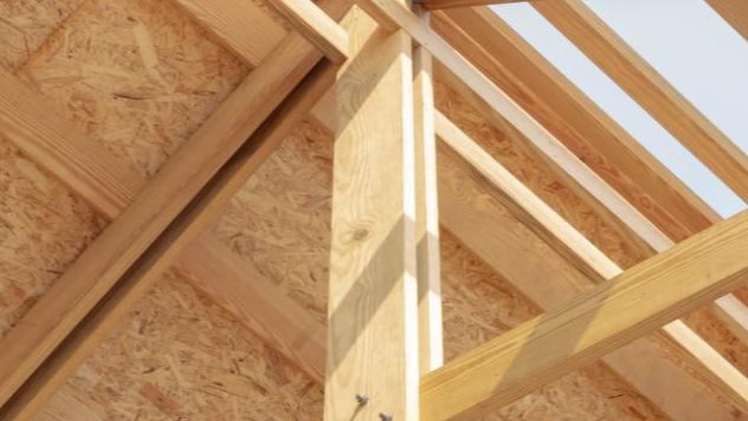Fastening of wooden rafters is available in both chicken breast forms. The home builder company บริษัทรับสร้างบ้าน will choose to use to provide continuous ventilation at the roof ridge. or as a louver on the gable panel
- The chicken breast helps to hold the ends of the rafters together on both sides.
- The depth of the chicken breasts should be the same depth as the sides of the rafters.
- rafters on the rafter head Helps to resist lifting forces due to wind loads.
- Use the rafter size 1″ × 6″ or 1″ × 8″ in case of hitting the sky directly next to the rafters. Instead, use 2″ thick rafters and secure with 3 10d nails.
- 4 lateral or 8d chicken breasts to the top and bottom rafters with 2 10d nails or 2 16d nails for double breasts. And the depth of the chicken breasts should not be less than the depth of the rafters.
- Attach the rafters to the chicken breast with nails. Use chicken breasts 1″ to 2″ thick.
Fastening the rafters on the eaves for building a house รับสร้างบ้าน or other construction It is fastened with 5 10d nails on the top and 2 16d on the bottom on each side.
- Wooden joist to fix the column head or ceiling.
- Steel fixing to resist the lifting of the roof.
Eaves support rafters
- The critical depth of the rafters
- Bird’s Mouth is to cut a rafter in the lower abdomen at right angles. To provide a contact area and to achieve better hold but be careful not to cut the wood too much. until the depth of the rafters is less than the critical depth
- Double or single support to support the rafters.
- Eaves assembly
- Fix with nails 16d @4″(100)
- Floor plank
- Support attic floor or ceiling joist.
- Closing stick
- Double stick
- Wall frame
- Seat Cut is to cut the rafters at the bottom end to make them sit on the support beams. for more contact area and better hold
- The end of the rafter extends from the outer wall.
- The wind sculpture and the wind sculpture are slightly protruding from the eaves. to cover the ends of the eaves and the gutter (if any)
- Closing the end of the eaves by notching at an angle to fit the wind molding.
- Closing the end of the wind sculpture by enclosing the eaves.
- The eaves ceiling runs back into the gable front wall.
Should pay attention to the details of the collision between the tip of the wind sculpture and the eaves.
Eaves without ceiling
- Perforated cleat for ventilation, covered with mesh.
- rafters
- The tip of the rafters may be cut into a pattern for beauty.
- roof covering material
- eaves
- Wooden rafters
gable overhang
- Cover material
- roof
- Puck Sot
- gable wall
- Metal rim allows water to drip.
- Floor covering for wind molding.
- Coordinate the connection between the wind molding and cover the wind molding with the eaves and rain gutters (if any).
- The wind tip is designed to drip water. and for beauty
- The rafters of the gable façade
- rafters
- Ceiling
- Bua closed the eaves.
wide eaves
- rafters
- Wood covering the head of the wall frame.
- Thickness 2″
- Bua closed the eaves.
- Air vents run continuously.
- roof covering material
- eaves
- Wooden rafters
- Ceiling
- The ceiling is overhanging.
always gable
- rafters
- Puck Sot
- gable wall
- roof covering material
- Metal rim allows water to drip.
- Floor covering for wind molding.
- Bua closed the eaves.
- Coordinate the connection of wind molding and cornice cover with eaves and rain gutters (if any).
narrow eaves
- The rafters are notched at right angles to support the truss headboard.
- Wall covering material
- Eave cover material
- eaves
- Wooden rafters
- Air vents run continuously.
- It has a pattern similar to a wide eaves.
barrier
- Cover the lintel with metal or concrete.
- Construction material panels at least 8″ (205) high.
- Sealant
- Place the roof over the shoulder at a distance of at least 3″ (75).
- The roof joists are fixed by anchor bolts measuring ∅½” (13) with a distance of not more than 6′ (1,830).
- Concrete block walls.
- Tong roof
- Fixing bar not more than 6′ (1,525) at all distances.
- At least 3″ × 8″ roof joists are attached to the wall with anchor bolts.
- reinforcing steel
- Cover over the roof made of metal or wood.
- Sealant
- Tong roof
- 2″ thick cleat
- Thick cleat cleat 1
- Wall frame
flat roof
- The joists are secured on each side by a bracket with 3 bolts or nails of size 8d or 2 of 16d.
- Single or double joists are fixed to the wall with built-in bolts.
- Closed roof structure. There should be air vents to prevent stuffiness inside the roof frame.
- Insulation
- Vents
- wooden frame wall
- A flat roof will not protect the walls. And there is also a chance that water will seep in easily.

